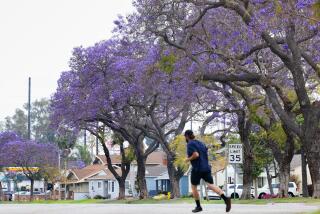Orchid lovers and their flowers will bloom at Botanic Garden show and sale.
Orchids are lovely, even exotic, flowers, favored above most other blossoms for luxurious corsages.
But cultivating and collecting them can be downright pathological, according to some orchid fanciers.
“It’s a disease, orchiditis. It’s symptoms are a lack of control when it comes to orchids,” says Michol Colgan, president of the 120-member South Bay Orchid Society. Those afflicted fill their yards and homes with hundreds of orchids; they devote hours a week to watering and repotting their plants; some spend thousands of dollars to build back-yard greenhouses that are soon bursting with the lavender, brown or yellow flowers that can resemble stars or butterflies and produce a congruence of petals that look like slippers or little dolls.
Florence Jacobsen says she’s devoted to the nearly 700 cymbidium orchids growing in her yard. But, she says, some of her friends don’t call it devotion. “They say I’m demented.”
Why this allegiance to a not-too-pretty plant that sometimes doesn’t even have the courtesy to bloom? It’s a combination of variety--there are more than 30,000 species--and the aura of luxury that orchids acquired centuries ago.
This Saturday and Sunday, orchid society members will try to demonstrate the allure of their favorite plant at their ninth annual show and sale at the South Coast Botanic Garden on the Palos Verdes Peninsula.
About 2,000 orchids will be on view. Show Chairman Jim Weiss said anyone who has owned an orchid plant for at least 60 days may bring it in for judging, which will take place Saturday morning. Ribbons will be awarded based on plant structure and the number, shape and color of flowers.
Videos shown every two hours will present the history and care of orchids, and society members will be there to field questions. The first 500 women will receive complimentary floral sprays.
Collectors say orchids are popular simply because nature has produced so many varieties. Although their primary habitat is the tropics, Colgan said they “grow up to altitudes of 5,000 feet, in cool climates, in the desert and the jungle.”
Some are hearty enough to grow outdoors, rain or shine, while others need the pampering of a greenhouse. Many can be bought for a few dollars, while some one-of-a-kind hybrids can fetch a price of $20,000.
But Weiss said all orchids make some demands on their owners: “They can’t just be stuck in the ground. The majority grow in pots and they have to be cared for. It’s simply watering, but not over-watering, proper fertilization and providing the proper light.”
And, he said, they may never bloom--something that adds to the excitement of seeing a plant flower for the first time.
Orchids became associated with wealth during the days of European exploration, when explorers brought them to England from the tropics. The privileged built greenhouses for the plants, said Weiss.
Clark Day Jr., a retired commercial orchid grower, said orchids became serious business in England. One plant drew 5,000 pounds at auction in an era when a pound was worth $5. “People would try to find out where they were obtained, but the explorers would conceal the locales,” he said. “Some species were lost for 100 years before they were rediscovered.”
Even though no one has to be rich to own orchids these days, the mystique lingers. “There’s the exotic bit,” said Robert Streeter, who has been raising orchids for 35 years. “You’re growing something that has a reputation of being the ultimate, plus being a beautiful, beautiful flower.”
Botanic garden foundation Executive Director Norma Cantafio said the orchid show draws one of the garden’s biggest crowds every year--perhaps that’s because coastal Southern California is ideal orchid country.
Hardy cymbidiums, with their tall spikes that may carry up to 25 blooms, are the local favorites.
Streeter said that even some plants that would demand a greenhouse elsewhere thrive outdoors here because it’s close to the beach and there is no frost. “I’ve moved plants out of my greenhouse and they’ve done better outdoors,” he said.
Last year’s show left little doubt about the South Bay’s devotion to orchids. Weiss said a Santa Ana condition sent temperatures to 105 degrees, but 1,700 people showed up anyway. “We hope it’s cooler this year and that we have even more people.”






